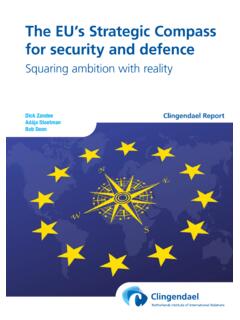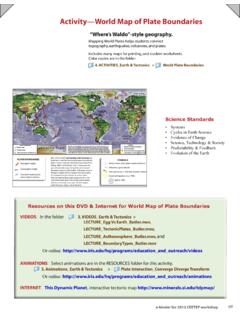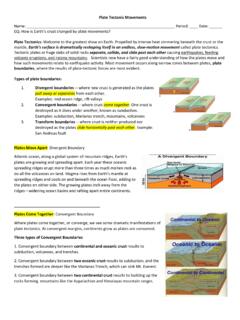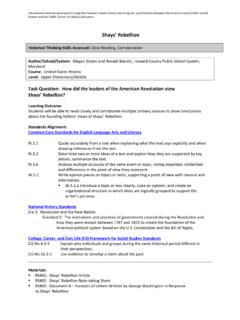Transcription of The roots of Mali’s conflict - Netherlands Institute of ...
1 The roots of Mali s conflictMoving beyond the 2012 crisisThe roots of Mali s conflictGr gory ChauzalThibault van DammeCRU ReportThe roots of Mali s conflictMoving beyond the 2012 crisisGr gory Chauzal Thibault van DammeCRU reportMarch 2015 The Sahel Programme is supported by March 2015 Netherlands Institute of International Relations Clingendael. All rights reserved. No part of this book may be reproduced, stored in a retrieval system, or transmitted, in any form or by any means, electronic, mechanical, photocopying, recording, or otherwise, without the prior written permission of the copyright holders.
2 About the authorsGr gory Chauzal is a senior research fellow at Clingendael s conflict Research Unit. He specialises in Mali/Sahel issues and develops the Maghreb-Sahel Programme for the Van Damme works for Clingendael s conflict Research Unit as a project assistant for the Maghreb-Sahel CRUThe Netherlands Institute of International Relations Clingendael is a think tank and diplomatic academy on international affairs. The conflict Research Unit (CRU) is a specialized team within the Institute , conducting applied, policy-oriented research and developing practical tools that assist national and multilateral governmental and non-governmental organizations in their engagement in fragile and conflict -affected situations.
3 Clingendael Institute Box 930802509 AB The HagueThe NetherlandsEmail: of ContentsAcknowledgements 6 Executive summary 8 Introduction 101. The 2012 crisis: the fissures of a united insurrection 102. A coup in the south 123. Amadou Toumani Tour : a scapegoat for the 2012 crisis? 134. Structure of the paper 15 Chapter 1. The failed path to national unity 17 Section 1: The dominance of the south in the aftermath of decolonisation 171. Historical fault lines between the north and the south 172.
4 Divide-and-rule strategies 193. Favouritism and patronage: Bamako s appointment logic 204. The primacy of military means to enforce national unity 215. Bypassing the Malian state: foreign aid and religious influences 22 Section 2: Economic inequalities between north and south 241. North Mali: from economic asset to liability 252. From local liability to regional security threat 263. Deliberate underdevelopment of the northern region 27 Conclusion 29 Chapter 2. Rebellion and fragmentation in northern Mali 30 Section 1: Constant rebellion: the historical continuity of Tuareg anger 301.
5 1963-1991: post-colonial rebellions and Bamako s military responses 312. Post-democratic rebellions and community divisions in the north 323. Tuareg rebellions under the ATT regime: disunity, interference and terrorism 324. The aftermath of the Tuareg rebellions: state withdrawal and security vacuum 345. Northern disunity as a main cause of instability? 34 Section 2: Origins and political allegiances of the northern communities 361. Tuareg communities: disunity within pluralism 362. The Arabs: revolt from the margins 383.
6 The Songhay and the Fulani 394. Bamako s northern militias: a proxy counter-insurgency strategy 40 Conclusion 415 The roots of Mali s conflict | CRU report, March 2015 Chapter 3. A playing field for foreign powers 43 Section 1: Regional interference based on geopolitical interest: Libya and Algeria 431. Libya in Mali: support to rebels and patronage 442. Algeria s natural backyard 46 Section 2: The security focus of the international community 471. The Sahel: from a terra nullius to a hotspot in the arc of crisis 482.
7 International plans to fight terrorism in northern Mali 483. Security without trust: the failure of the fight against terrorism in northern Mali 50 Conclusion 51 Conclusions: a way out of recurrent crisis? 521. International coordination as a first step to normalisation 532. Endogenous solutions to the Malian crisis 543. Re-legitimating the Malian state 56 Abbreviations 59 Bibliography 606 AcknowledgementsThe authors would like to thank all their colleagues from the Clingendael Institute s conflict Research Unit, especially Rosan Smits, Ivan Briscoe, Jort Hemmer and Mariska van Beijnum for their invaluable assistance during and after the editing of this paper.
8 We also want to acknowledge Janny Krayema for her outstanding availability regarding our numerous queries on articles and books. Very special thanks go to Virginie Baudais for her thoughtful peer review and the very high quality of her expert inputs. Finally, thanks for editing go to Paula McDiarmid and for typesetting to Textcetera. The contents of the report remain the authors of MaliBeninBurkina FasoCote D'IvoireAlgeriaGhanaGuineaMaliMauritania NigerNigeriaSenegalSierraLeoneTogoBamako KayesSikassoS gouMoptiTimbuktuNigerRiverTaoudenniKidal Gao8 Executive summaryFrom January to April 2012, Mali underwent the fourth Tuareg uprising of its post-colonial history, an Islamist takeover of all the northern cities and an improvised military coup.
9 This succession of destabilising events came as a surprise to all international observers, who long considered this country as a poster child for democracy in Africa . In their view, deposed President Amadou Toumani Tour (ATT) appeared to shoulder the prime responsibility for the 2012 crisis. And while it is without doubt accurate to say that the former leader of Mali contributed in large part to the political degradation and worsening security conditions of the country, the root causes of the conflict are to be found elsewhere, predating ATT s paper, the first report of the new Maghreb-Sahel Programme of the Clingendael Institute s conflict Research Unit, aims to explore the most prominent root causes and global influences that account for the 2012 crisis.
10 It addresses the local issues that have played a significant role in undermining peace and security and explores the international dynamics that have contributed to this malaise. On the basis of that analysis, the paper seeks to give the many local and international bodies now engaged in the Sahel region, and in Mali in particular, food for thought as to what political, social and developmental challenges remain to be addressed so as to prevent a recurrence of armed conflict and institutional collapse. The paper should serve as a clear warning to all those who believe the international community can move on once the immediacy of crisis management in Mali has Mali gained independence from France in 1960, the new government had to assert its authority on a large territory, including desert regions where Tuareg and Arab communities directly challenged its authority.









